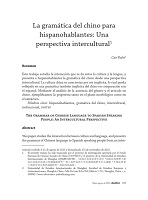The Grammar of Chinese Language to Spanish Speaking People: An Intercultural Perspective
DOI:
https://doi.org/10.32870/mycp.v5i14.508Keywords:
spanish speaker, Chinese grammar, intercultural, isofunctional, unitypAbstract
This paper studies the interaction between culture and language, and presents the grammar of Chinese language to Spanish speaking people from an intercultural perspective. The Chinese culture is characterized by being implicit, which is reflected in a grammar also implicit in comparison with Spanish. Through the analysis on the absence of gender and the article in Chinese, we exemplify the proposal from morphological and syntactic aspects.Downloads
References
Cao, Y. (2014a), “La definitud en chino: una breve comparación entre español y chino”, México y la Cuenca del Pacífico, 3(8), pp. 61-74.
Cao, Y. (2014b), “Clasificación nominal y anáfora: comparación entre espa- ñol y chino”, Círculo de lingüística aplicada a la comunicación, 59, pp. 3-15. Doi:10.5209/rev_CLAC.2014.v59.46706.
Cervantes Saavedra, Miguel de (1995), “Aventura de los molinos de viento,” El ingenioso hidalgo Don Quijote de la Mancha”, traducción de J. Liu, China, Lijiang.
Chen, P. (2004), “Identifiability and Definiteness in Chinese”, Linguistics, 42(6), pp. 1129-1184. Doi: 10.1515/ling.2004.42.6.1129
Diao, S. (2007), “The Referential Properties of Bare no and their Syntactic Distribution”, Journal of Hubei Normal University (Philosophy and Social Science), 27(1), pp. 71-75. La gramática del chino para hispanohablantes: Una perspectiva intercultural Mayo-agosto de 2016. Análisis 115
Enfield, N. (ed.) (2002), Ethnosyntax: Explorations in grammar and culture, Oxford, u.k., Oxford University Press.
Everett, D. L. (2015), “The Role of Culture in the Emergence of Language”, en B. MacWhinney y W. O’Grady, (ed.), The Handbook of Language Emergence, New Jersey, Wiley Blackwell, pp. 354-376.
García-Miguel, J. M. (2000), “Clasificación nominal, concordancia y pronombres”, Estudios de lingüística (14), pp. 93-116.
Hundius, H. y U. Kölver (1983), “Syntax and Semantics of Numeral Classifiers in Thai”, Studies in Language, 7 (2), pp. 165-214. Doi: 10.1075/ sl.7.2.02hun.
Iturrioz, J. L. (1986a), “El proyecto de tipología y universales de Colonia (unityp)”, Funcion, 1(1), pp. 19-33.
Iturrioz, L.L. (1986b), “Individuation and Determination i: On the Interaction of both Dimensions in the Use of the Articles and Other Phenomena Related to Nominal Subcategorization and Reference”, Funcion, 1(2), pp. 201-245.
Kaplan, R. B. (1966), “Cultural thought Patterns in Inter-cultural Education”, Language Learning: A Journal of Applied Linguistics, 16(1-2), pp. 1-20. Doi: DOI: 10.1111/j.1467-1770.1966.tb00804.x.
Leonetti, M. (1999), Los determinantes, Madrid, Arco Libros.
Lu, J. (2008), “Distancia interlingüística: partida de reflexiones metodológicas del español en el contexto chino”, México y la Cuenca del Pacífico, 11(32), pp. 45-56.
Lyons, C. (1999), Definiteness, New York, Cambridge University Press.
Martínez, A. (2015), “¿Cómo afecta la cultura a la gramática? El caso de los clíticos en el español americano”, Círculo de Lingüística Aplicada a la Comunicación, 61, pp. 186-210.
Moreno, J. C. (1991), Curso universitario de lingüística general, t. i, Teoría de la gramática y sintaxis general, Madrid, Síntesis.
Real Academia de la Lengua Española (2010), Nueva gramática de la lengua española: Manual, Madrid, Espasa. Xu, Y. (1992), Introducción a la lingüística contrastiva, Shanghai, Waijiaoshe.
Xu, Y. (1992), Introducción a la lingüística contrastiva, Shanghai, Waijiaoshe.

Downloads
Published
How to Cite
Issue
Section
License
Open Access Policy
This journal provides open access to all its contents, in adherence to the principle that making research freely available supports a greater global exchange of knowledge.
MyCP is licensed under a Creative Commons Attribution-NonCommercial license, also known as CC BY-NC.
Contents are published in both PDF and XML formats.
Authors who publish in México y la Cuenca del Pacífico must accept the following conditions:
Pursuant to Mexican copyright laws, México y la Cuenca del Pacífico acknowledges and respects the authors’ moral right and ownership of property rights, which will be assigned to the University of Guadalajara to publish the articles in an open-access mode.
México y la Cuenca del Pacífico does not charge the authors any fees for receiving and processing their articles.
Authors are permitted to enter into other independent and additional contractual agreements for the non-exclusive distribution of the article version published in México y la Cuenca del Pacífico (for example, publishing it in an institutional repository or in other printed or electronic media) as long as they clearly state that the piece was originally published in México y la Cuenca del Pacífico.
Pursuant to the above, once the article is approved for publication, authors must send the Assignment of Rights Agreement form duly filled and signed. This form must be sent to mexicoylacuenca@gmail.com as a PDF file.
Readers/users of México y la Cuenca del Pacífico can freely access the journal new issues as soon as they are uploaded. Readers/users are allowed to cite, share (both electronically and physically), print and distribute the material, provided they expressly state that the work was originally published in México y la Cuenca del Pacífico. Contents are to be properly cited and never for commercial purposes.




